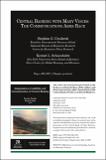Mostrar el registro sencillo del ítem
Central banking with many voices: the communications arms race
| dc.contributor.author | Cecchetti, Stephen G. | |
| dc.contributor.author | Schoenholtz, Kermit L. | |
| dc.date.accessioned | 2021-10-19T14:54:06Z | |
| dc.date.available | 2021-10-19T14:54:06Z | |
| dc.date.issued | 2021-10 | |
| dc.identifier.isbn | 978-956-7421-69-5 | |
| dc.identifier.isbn | 978-956-7421-70-1 (pdf) | |
| dc.identifier.issn | 0717-6686 | |
| dc.identifier.uri | https://hdl.handle.net/20.500.12580/6135 | |
| dc.description | The job of central bankers is to use the monetary powers granted to them to promote price stability, sustainable growth, and a stable financial system. They do this in an environment fraught with unavoidable uncertainties. But, in conducting policy, there is one uncertainty that policymakers can and should reduce: the uncertainty they themselves create. Everyone agrees that monetary policymakers should do their best to minimize the noise that their actions add to the environment. When policy is transparent and effective, people in the economy and financial markets respond to the data, not to the policymakers. During the past quarter-century, the evolution of an ever more detailed inflation-targeting framework facilitated a vast improvement in Federal Open Market Committee (FOMC) communication. Over the same period, both the level and uncertainty of inflation have declined. We infer that since the mid-1990s, the U.S. economy has been reaping the benefits of a credible commitment to price stability, including a communications framework that reinforces that commitment. | es |
| dc.description.abstract | The job of central bankers is to use the monetary powers granted to them to promote price stability, sustainable growth, and a stable financial system. They do this in an environment fraught with unavoidable uncertainties. But, in conducting policy, there is one uncertainty that policymakers can and should reduce: the uncertainty they themselves create. Everyone agrees that monetary policymakers should do their best to minimize the noise that their actions add to the environment. When policy is transparent and effective, people in the economy and financial markets respond to the data, not to the policymakers. During the past quarter-century, the evolution of an ever more detailed inflation-targeting framework facilitated a vast improvement in Federal Open Market Committee (FOMC) communication. Over the same period, both the level and uncertainty of inflation have declined. We infer that since the mid-1990s, the U.S. economy has been reaping the benefits of a credible commitment to price stability, including a communications framework that reinforces that commitment. | es |
| dc.format | ||
| dc.format.extent | Sección o Parte de un Documento | |
| dc.format.medium | p. 343-412 | |
| dc.language.iso | en | es |
| dc.publisher | Banco Central de Chile | es |
| dc.relation.ispartofseries | Series on Central Banking Analysis and Economic Policies; no. 28 | |
| dc.relation.ispartofseries | Serie Banca Central, análisis y políticas económicas; no. 28 | |
| dc.rights | Attribution-NonCommercial-NoDerivs 3.0 Chile | * |
| dc.rights.uri | http://creativecommons.org/licenses/by-nc-nd/3.0/cl/ | * |
| dc.subject | BANCOS CENTRALES | es |
| dc.subject | COMUNICACIÓN | es |
| dc.subject | POLITICA MONETARIA | es |
| dc.subject | MERCADO FINANCIERO | es |
| dc.subject | BANQUEROS CENTRALES | es |
| dc.title | Central banking with many voices: the communications arms race | es |
| dc.type.doc | Artículo |


